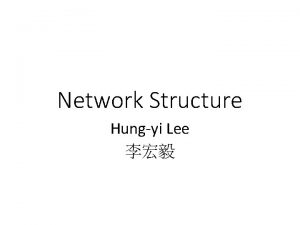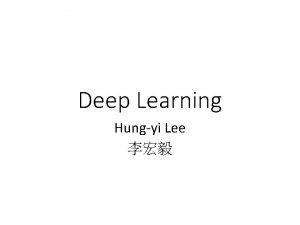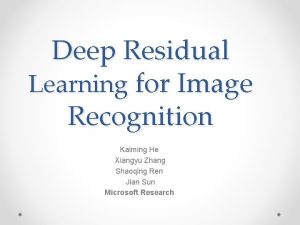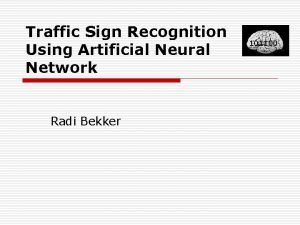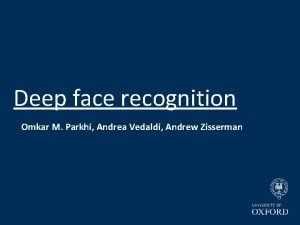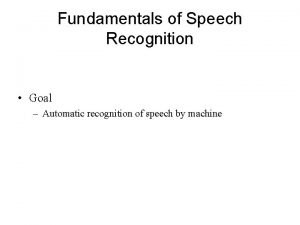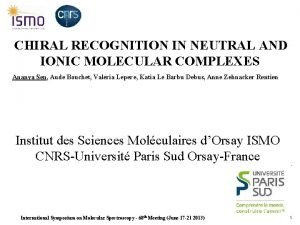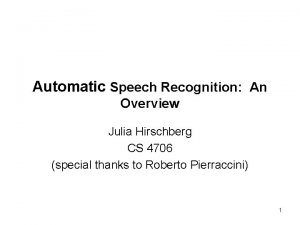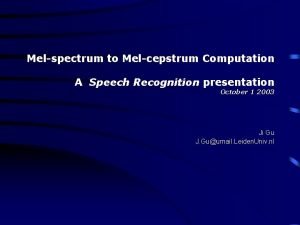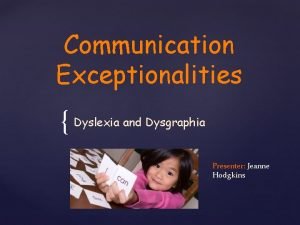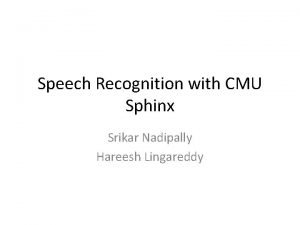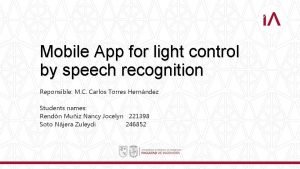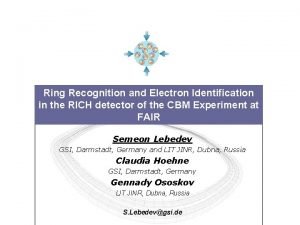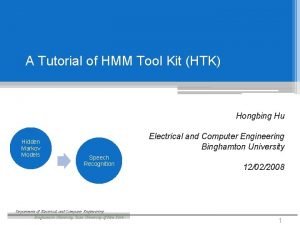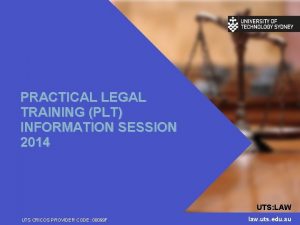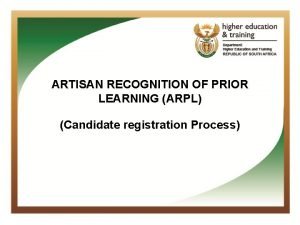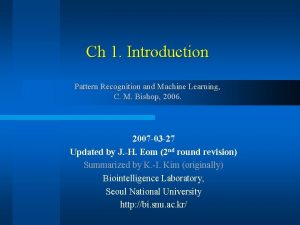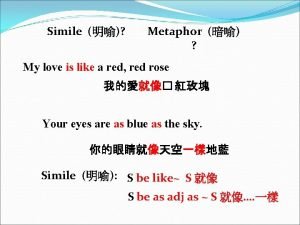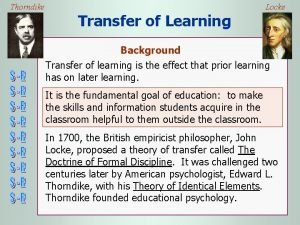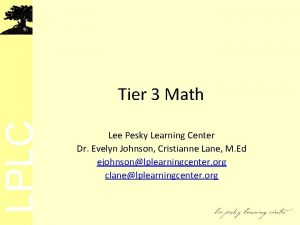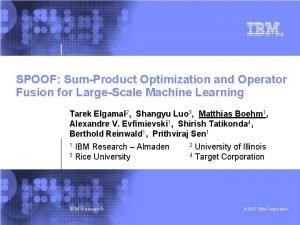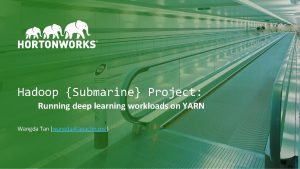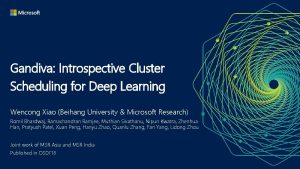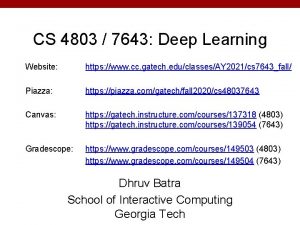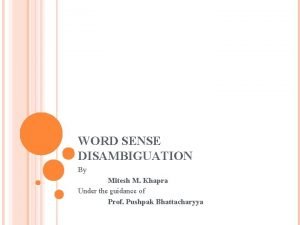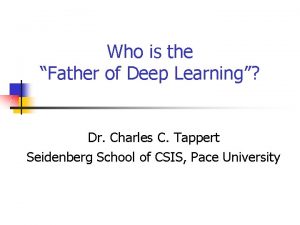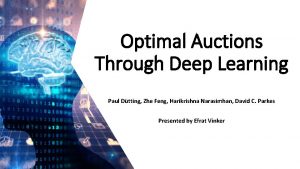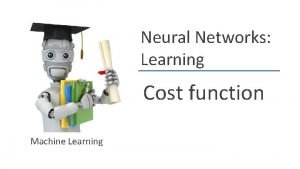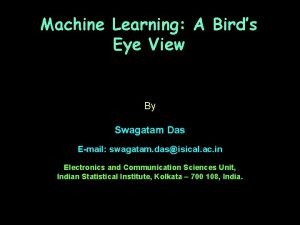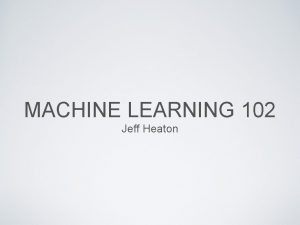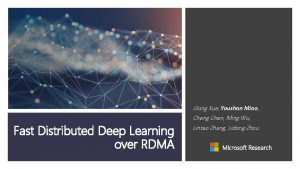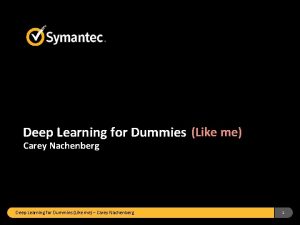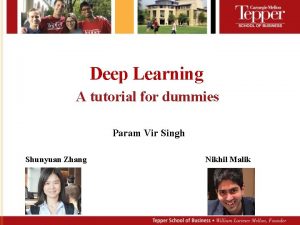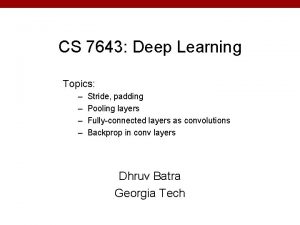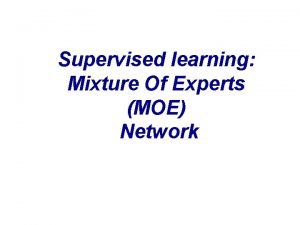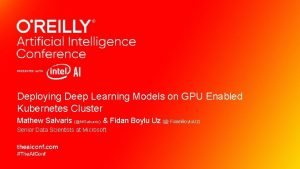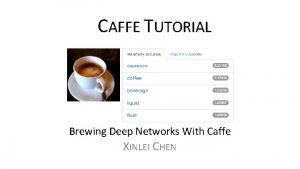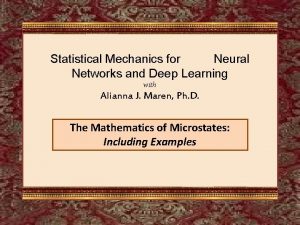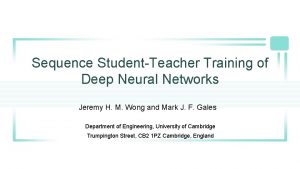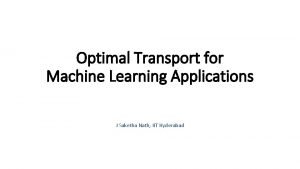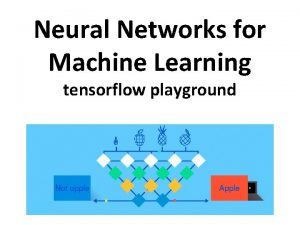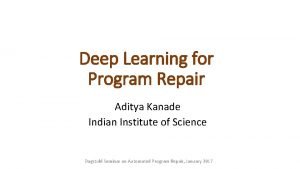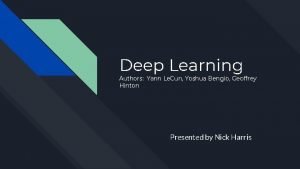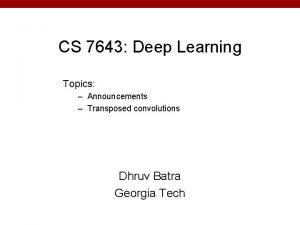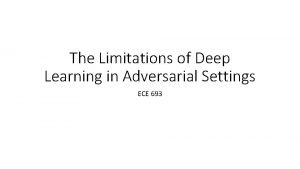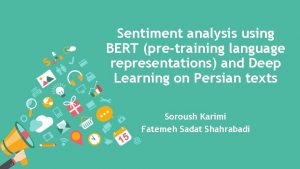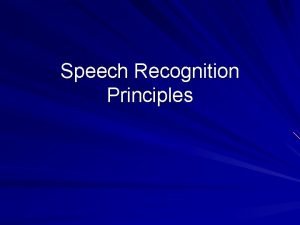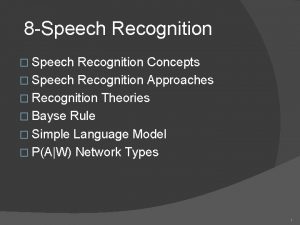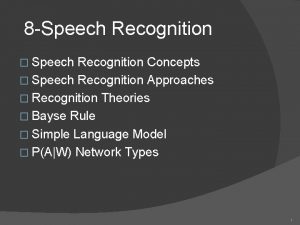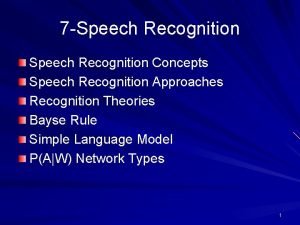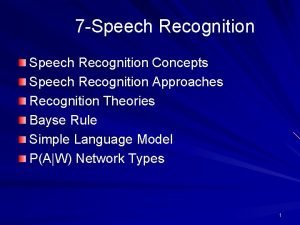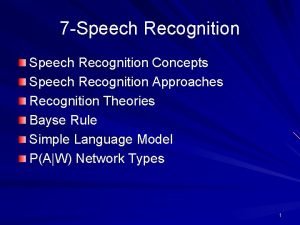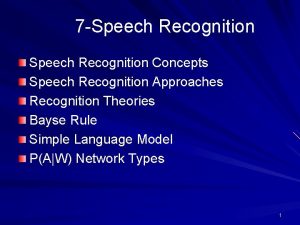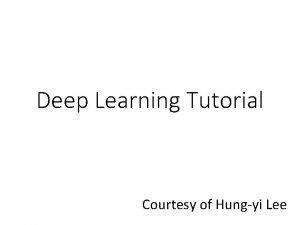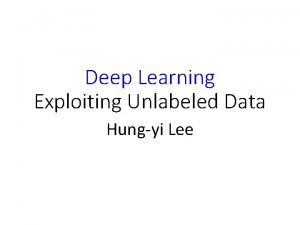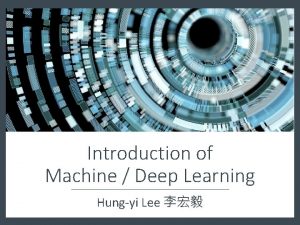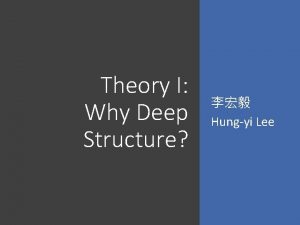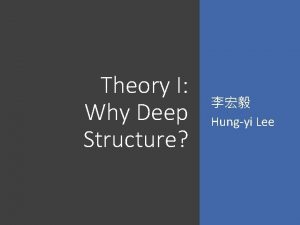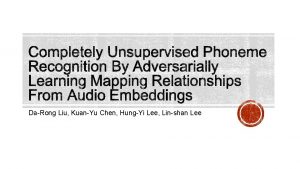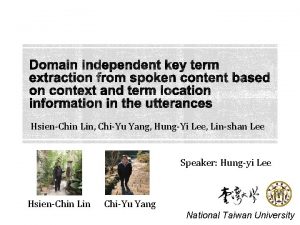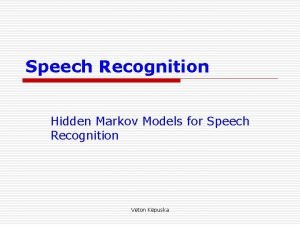Deep Learning for Speech Recognition Hungyi Lee Outline




































































- Slides: 68

Deep Learning for Speech Recognition Hung-yi Lee

Outline • Conventional Speech Recognition • How to use Deep Learning in acoustic modeling? • Why Deep Learning? • Speaker Adaptation • Multi-task Deep Learning • New acoustic features • Convolutional Neural Network (CNN) • Applications in Acoustic Signal Processing

Conventional Speech Recognition

Machine Learning helps X Speech Recognition 天氣真好 This is a structured learning problem. Inference:

Input Representation • Audio is represented by a vector sequence X: …… x 1 x 2 x 3 …… 39 dim MFCC

Input Representation - Splice • To consider some temporal information MFCC Splice …… ……

Phoneme • Phoneme: basic unit Each word corresponds to a sequence of phonemes. Lexicon what do you think Lexicon Different words can correspond to the same phonemes hh w aa t d uw y uw th ih ng k

State • Each phoneme correspond to a sequence of states what do you think Phone: hh w aa t d uw y uw th ih ng k Tri-phone: …… t-d+uw d-uw+y uw-y+uw y-uw+th …… t-d+uw 1 t-d+uw 2 t-d+uw 3 d-uw+y 1 d-uw+y 2 d-uw+y 3 State:

State • Each state has a stationary distribution for acoustic features Gaussian Mixture Model (GMM) t-d+uw 1 P(x|”td+uw 1”) d-uw+y 3 P(x|”d-uw+y 3”)

State • Each state has a stationary distribution for acoustic features Tied-state pointer P(x|”d-uw+y 3”) Same Address pointer P(x|”td+uw 1”)

Acoustic Model W what do you think? : S: a b c d e …… …… s 1 X: s 2 s 3 s 4 P(X|W) = P(X|S) s 5 …… x 1 x 2 x 3 x 4 x 5 transition emission

Acoustic Model W what do you think? : S: a b c d e …… P(X|W) = P(X|S) Actually, we don’t know the alignment. s 1 s 2 s 3 s 4 s 5 X: …… x 1 x 2 x 3 x 4 x 5 (Viterbi algorithm)

How to use Deep Learning?

People imagine …… …… …… Acoustic features This can not be true! DNN can only take fixed length vectors as input. DNN “Hello”

What DNN can do is …… P(a|xi) P(b|xi) P(c|xi) …… …… Size of output layer = No. of states DNN …… Ø DNN input: One acoustic feature Ø DNN output: Probability of each state …… xi

Low rank approximation Output layer M W N Input layer W: M X N N is the size of the last hidden layer M is the size of output layer Ø Number of states M can be large if the outputs are the states of tri-phone.

Low rank approximation K N N V K M W ≈ M U K < M, N Less parameters Output layer M Output layer linear W N M U K V N

How we use deep learning • There are three ways to use DNN for acoustic modeling • Way 1. Tandem Efforts for exploiting • Way 2. DNN-HMM hybrid deep learning • Way 3. End-to-end

How to use Deep Learning? Way 1: Tandem

Way 1: Tandem system P(a|xi) P(b|xi) P(c|xi) …… …… Size of output layer = No. of states DNN …… Input of your original speech recognition system …… xi Last hidden layer or bottleneck layer are also possible.

How to use Deep Learning? Way 2: DNN-HMM hybrid

Way 2: DNN-HMM Hybrid From DNN …… DNN Count from training data

Way 2: DNN-HMM Hybrid DNN …… DNN From original HMM Count from training data This assembled vehicle works …….

Way 2: DNN-HMM Hybrid • Sequential Training increase decrease

How to use Deep Learning? Way 3: End-to-end

Way 3: End-to-end - Character Input: acoustic features (spectrograms) Output: characters (and space) + null (~) No phoneme and lexicon (No OOV problem) A. Hannun, C. Case, J. Casper, B. Catanzaro, G. Diamos, E. Elsen, R. Prenger, S. Satheesh, S. Sengupta, A. Coates, A. Ng ”Deep Speech: Scaling up end-to-end speech recognition”, ar. Xiv: 1412. 5567 v 2, 2014.

Way 3: End-to-end - Character HIS FRIEND’S ~~ ~~ ~ ~~ Graves, Alex, and Navdeep Jaitly. "Towards end-to-end speech recognition with recurrent neural networks. " Proceedings of the 31 st International Conference on Machine Learning (ICML-14). 2014.

Way 3: End-to-end – Word? apple bog cat …… Output layer ~50 k words in the lexicon DNN padding with zero! Size = 200 times of acoustic features Input layer … … Use other systems to get the word boundaries Ref: Bengio, Samy, and Georg Heigold. "Word embeddings for speech recognition. “, Interspeech. 2014.

Why Deep Learning?

Deeper is better? Seide, Frank, Gang Li, and Dong Yu. "Conversational Speech Transcription Using Context-Dependent Deep Neural Networks. " Interspeech. 2011. • Word error rate (WER) multiple layers Deeper is Better 1 hidden layer

Deeper is better? Seide, Frank, Gang Li, and Dong Yu. "Conversational Speech Transcription Using Context-Dependent Deep Neural Networks. " Interspeech. 2011. • Word error rate (WER) multiple layers 1 hidden layer Deeper is Better For a fixed number of parameters, a deep model is clearly better than the shallow one.

What does DNN do? A. Mohamed, G. Hinton, and G. Penn, “Understanding how Deep Belief Networks Perform Acoustic Modelling, ” in ICASSP, 2012. • Speaker normalization is automatically done in DNN Input Acoustic Feature (MFCC) 1 -st Hidden Layer

What does DNN do? A. Mohamed, G. Hinton, and G. Penn, “Understanding how Deep Belief Networks Perform Acoustic Modelling, ” in ICASSP, 2012. • Speaker normalization is automatically done in DNN Input Acoustic Feature (MFCC) 8 -th Hidden Layer

What does DNN do? • In ordinary acoustic models, all the states are modeled independently • Not effective way to model human voice high low front back The sound of vowel is only controlled by a few factors. http: //www. ipachart. com/

What does DNN do? front back high Vu, Ngoc Thang, Jochen Weiner, and Tanja Schultz. "Investigating the Learning Effect of Multilingual Bottle-Neck Features for ASR. " Interspeech. 2014. Output of hidden layer reduce to two dimensions /i/ low /u/ /e/ /o/ /a/ Ø The lower layers detect the manner of articulation Ø All the states share the results from the same set of detectors. Ø Use parameters effectively

Speaker Adaptation

Speaker Adaptation • Speaker adaptation: use different models to recognition the speech of different speakers • Collect the audio data of each speaker • A DNN model for each speaker • Challenge: limited data for training • Not enough data for directly training a DNN model • Not enough data for just fine-tune a speaker independent DNN model

Categories of Methods Conservative training • Re-train the whole DNN with some constraints Transformation methods • Only train the parameter of one layer Speaker-aware Training • Do not really change the DNN parameters Need less training data

Conservative Training Output layer output close Output layer parameter close initialization Input layer Audio data of Many speakers Input layer A little data from target speaker

Transformation methods Add an extra layer Output layer Fix all the other parameters Output layer i+1 W Input layer i+1 layer i W Wa Input layer extra layer i A little data from target speaker

Transformation methods • Add the extra layer between the input and first layer • With splicing …… …… layer 1 extra layers extra layer Wa Larger Wa More data Wa Smaller Wa Wa Wa less data

Transformation methods • SVD bottleneck adaptation Output layer M U linear Wa V K is usually small K N

Speaker-aware Training Can also be noiseaware, devise aware training, …… Lots of mismatched data Speaker information Data of Speaker 1 Data of Speaker 2 Data of Speaker 3 Fixed length low dimension vectors Text transcription is not needed for extracting the vectors.

Speaker-aware Training data: Speaker 1 train Output layer Speaker 2 Acoustic features are appended with speaker information features Testing data: test Acoustic Speaker feature Information All the speaker use the same DNN model Different speaker augmented by different features

Multi-task Learning

Multitask Learning • The multi-layer structure makes DNN suitable for multitask learning Task A Task B Input feature for task A for task B

Multitask Learning - Multilingual states of French states of German acoustic features states of Spanish states of Italian states of Mandarin Human languages share some common characteristics.

Multitask Learning - Multilingual Character Error Rate 50 45 Mandarin only 40 35 With European Language 30 25 1 10 1000 Hours of training data for Mandarin Huang, Jui-Ting, et al. "Cross-language knowledge transfer using multilingual deep neural network with shared hidden layers. " Acoustics, Speech and Signal Processing (ICASSP), 2013

Multitask Learning - Different units A acoustic features B A= state B = phoneme A= state B = gender A= state B = grapheme (character)

Deep Learning for Acoustic Modeling New acoustic features

MFCC spectrogram DFT Waveform DCT MFCC … …… Input of DNN log filter bank

Filter-bank Output spectrogram DFT Waveform … Ø Kind of standard now …… Input of DNN log filter bank

Spectrogram spectrogram DFT Waveform Ø common today Input of DNN Ø 5% relative improvement over fitlerbank output Ø Ref: ainath, T. N. , Kingsbury, B. , Mohamed, A. R. , & Ramabhadran, B. , “Learning filter banks within a deep neural network framework, ” In Automatic Speech Recognition and Understanding (ASRU), 2013

Spectrogram

Waveform? Input of DNN Ø If success, no Signal & Systems Waveform Ø People tried, but not better than spectrogram yet Ø Ref: Tüske, Z. , Golik, P. , Schlüter, R. , & Ney, H. , “Acoustic modeling with deep neural networks using raw time signal for LVCSR, ” In INTERPSEECH 2014 Ø Still need to take Signal & Systems ……

Waveform?

Convolutional Neural Network (CNN)

CNN • Speech can be treated as images Frequency Spectrogram Time

CNN Probabilities of states CNN Image Replace DNN by CNN

CNN Max pooling Max a 1 a 2 Maxout b 1 b 2 Max

CNN Tóth, László. "Convolutional Deep Maxout Networks for Phone Recognition”, Interspeech, 2014.

Applications in Acoustic Signal Processing

DNN for Speech Enhancement Clean Speech for mobile commination or speech recognition DNN Noisy Speech Ø Demo for speech enhancement: http: //home. ustc. edu. cn/~xuyong 62/demo/SE_DNN. html

DNN for Voice Conversion Female DNN Male Ø Demo for Voice Conversion: http: //research. microsoft. com/enus/projects/vcnn/default. aspx

Concluding Remarks

Concluding Remarks • Conventional Speech Recognition • How to use Deep Learning in acoustic modeling? • Why Deep Learning? • Speaker Adaptation • Multi-task Deep Learning • New acoustic features • Convolutional Neural Network (CNN) • Applications in Acoustic Signal Processing

Thank you for your attention!

More Researches related to Speech Find the lectures related to “deep learning” lecture recordings Summary Spoken Content Retrieval Speech Recognition I would like to leave Taipei on November 2 nd Computer Assisted Language Learning Information Extraction Speech Summarization 你好 core techniques Hi Hello Dialogue
 Deep learning speech recognition
Deep learning speech recognition Hungyi lee
Hungyi lee Hung yi lee
Hung yi lee Hungyi
Hungyi Hungyi lee
Hungyi lee Hungyi lee
Hungyi lee Kaiming he
Kaiming he Traffic sign recognition deep learning
Traffic sign recognition deep learning Omkar parkhi
Omkar parkhi Cmu machine learning
Cmu machine learning Tony wagner's seven survival skills
Tony wagner's seven survival skills Deep asleep deep asleep it lies
Deep asleep deep asleep it lies Deep forest towards an alternative to deep neural networks
Deep forest towards an alternative to deep neural networks 深哉深哉耶穌的愛
深哉深哉耶穌的愛 Kinect for windows runtime
Kinect for windows runtime Fundamentals of speech recognition
Fundamentals of speech recognition Aude leperre
Aude leperre Julia speech recognition
Julia speech recognition Melspectrum
Melspectrum How a dyslexic person sees text
How a dyslexic person sees text Cmu speech recognition
Cmu speech recognition Speech recognition
Speech recognition Speech recognition app inventor
Speech recognition app inventor Dragon speech recognition
Dragon speech recognition Electron speech to text
Electron speech to text Htk speech recognition tutorial
Htk speech recognition tutorial Uts llb
Uts llb What is arpl
What is arpl Cm bishop pattern recognition and machine learning
Cm bishop pattern recognition and machine learning Cuadro comparativo de e-learning b-learning y m-learning
Cuadro comparativo de e-learning b-learning y m-learning Quotation sandwhich
Quotation sandwhich My love for you is as deep as the ocean figure of speech
My love for you is as deep as the ocean figure of speech Deep speech baidu
Deep speech baidu Edward thorndike learning theory
Edward thorndike learning theory Lee pesky learning center
Lee pesky learning center Operator fusion deep learning
Operator fusion deep learning Gated recurrent unit in deep learning
Gated recurrent unit in deep learning Hadoop deep learning
Hadoop deep learning Gandiva: introspective cluster scheduling for deep learning
Gandiva: introspective cluster scheduling for deep learning Cs 7643 deep learning
Cs 7643 deep learning Autoencoders
Autoencoders Www.youtube.com
Www.youtube.com Mitesh kapra
Mitesh kapra Who is the father of deep learning?
Who is the father of deep learning? Optimal auctions through deep learning
Optimal auctions through deep learning Deep learning competencies 6 c's
Deep learning competencies 6 c's Neural network cost function
Neural network cost function Bird eye view deep learning
Bird eye view deep learning Jeff heaton github
Jeff heaton github Fast distributed deep learning over rdma
Fast distributed deep learning over rdma Carey nachenberg slides
Carey nachenberg slides Convolution for dummies
Convolution for dummies Cs 7643 deep learning github
Cs 7643 deep learning github Moe deep learning
Moe deep learning Analogizers
Analogizers Intel deep learning training tool
Intel deep learning training tool Kubernetes vgpu
Kubernetes vgpu Caffe framework tutorial
Caffe framework tutorial Caffe python tutorial
Caffe python tutorial Statistical mechanics of deep learning
Statistical mechanics of deep learning Student teacher neural network
Student teacher neural network Ioslides
Ioslides Playground tensor
Playground tensor Aditya kanade
Aditya kanade Le cun
Le cun Cs7643
Cs7643 Deep learning for limit order books
Deep learning for limit order books The limitations of deep learning in adversarial settings.
The limitations of deep learning in adversarial settings. ü
ü



